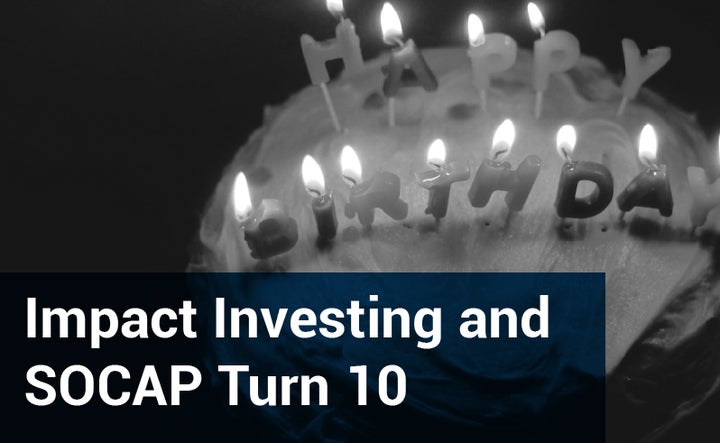
There’s a birthday party this week in San Francisco. SOCAP (Social Capital Markets) and impact investing are both celebrating their tenth birthday. This year’s SOCAP17 is being held at Fort Mason Center in San Francisco October 10 - 13. What began as a 1,000-attendee conference to explore possibilities within the burgeoning impact investing world has evolved into “the largest impact investing capital markets gathering in the world,” with over 3,000 attendees expected this year - the most ever.
A decade ago, the entry of impact investing marked a change in the landscape of socially responsible investments; whereas investors had previously focused on minimizing harm, many investors and entrepreneurs now sought to leverage the power of capital to “generate a measurable, beneficial social or environmental impact alongside a financial return.”
Lindsay Smalling, the curator and producer of SOCAP, said this is what sets impact investing apart from terms like ESG (environmental, social, and governance) investing and SRI (socially responsible investing).
“Those are screens; they’re more focused on screening out negative impact. In the beginning it was religious groups that didn’t want alcohol, prostitution, or gambling in their portfolios. Impact investing is a different category; it’s about creating positive impact and not just doing less harm. It’s a much more proactive and positive approach.”
SOCAP emerged as the global financial markets splintered. “The Great Recession got a lot of people questioning the thinking where you make as much money as you can, and then give it away to solve problems through philanthropy,” she said. “You could be doing a lot of harm amassing profit on the one side, and then just undoing it with the philanthropy. People started to see that there’s a better way, where you can make money and have a positive social impact at the same time.”
Smalling counts herself among those whose interest in impact investing was piqued by the Great Recession; although she had worked in both private finance and the nonprofit sector, 2008 is when she became interested in combining the two. She attended her first SoCap in 2010, joined the team in 2012, and became the primary director of content for the conference in 2015.
Although the conference has evolved since its inception, the mission remains the same. “We are a big tent organization. SOCAP is the place where it’s not about just having the right people in the room; it’s about opening up the tent to more and more people.” The focus is both on investors looking for a place to put their money as well as entrepreneurs looking to get funded.
When asked about her own contributions, Smalling is most proud of her emphasis on what she calls the “grassroots” nature of the conference. “My title is the ‘curator’” she reminded me. “I’m not deciding all of the programming, I’m focusing on facilitating conversations across the field.”
To that end, SoCap is instituting a new feature this year: “guest curated” spotlights. These are events and talks curated by outside organizations that are in some way related to impact investing. Smalling is especially proud of “an entire track devoted to racial equity with the Kellogg Foundation. That’s pretty unique, for a finance and investing conference to have a series of sessions dedicated to exploring race issues as they relate to investing, entrepreneurship, language, media, and more.”
“The actual physical convening of the community is invigorating and exciting for everyone,” Smalling said. “People are realizing that they can change the way they invest, purchase, and work; that they don’t have to check their values at the door.”
Smalling sees the potential of impact investing to address issues such as poverty and environmental concerns. She believes in a dichotomy of impact investing to address problems that the market can solve, and philanthropy or government for the rest.
“There’s a fear in the nonprofit and philanthropic world of impact investing. They think it’s going to put them out of business,” she said. “But the truth is that pretty much nobody in the world thinks that philanthropic dollars can solve the scale of the problems that exist. There are some problems that are never going to have market solutions, but there are others that can.”
She points to the microfinance industry as an engine of economic growth that can help underserved communities around the globe. “Just by giving people access to credit and access to capital, you can free up a whole world of entrepreneurs. Folks who might want to start their own small farming operation, or just need a sewing machine to make dresses for all the women in their village. New finance channels can unlock huge economic activity.”
SOCAP’s commitment is demonstrated by their scholarship program; this year, around 150 entrepreneurs all over the world will be flown in to attend. “A lot of conferences are targeted to investors and sometimes shun entrepreneurs,” Smalling said. “For us, it’s important to elevate both v oices. That’s where the rubber meets the road, and this is a way to help a lot of underprivileged entrepreneurs be a part of this community.”
As SOCAP attendees gather to celebrate a terrific ten, they’ll collaborate to fuel even greater impact in the decade ahead.. Lindsay Smalling is excited to be a major driver of that success. She believes that all investors should be maximizing the impact of their money, stressing that investors can generate positive social and financial returns.
“This is your money,” she said. “What’s it doing while you sleep at night?”
